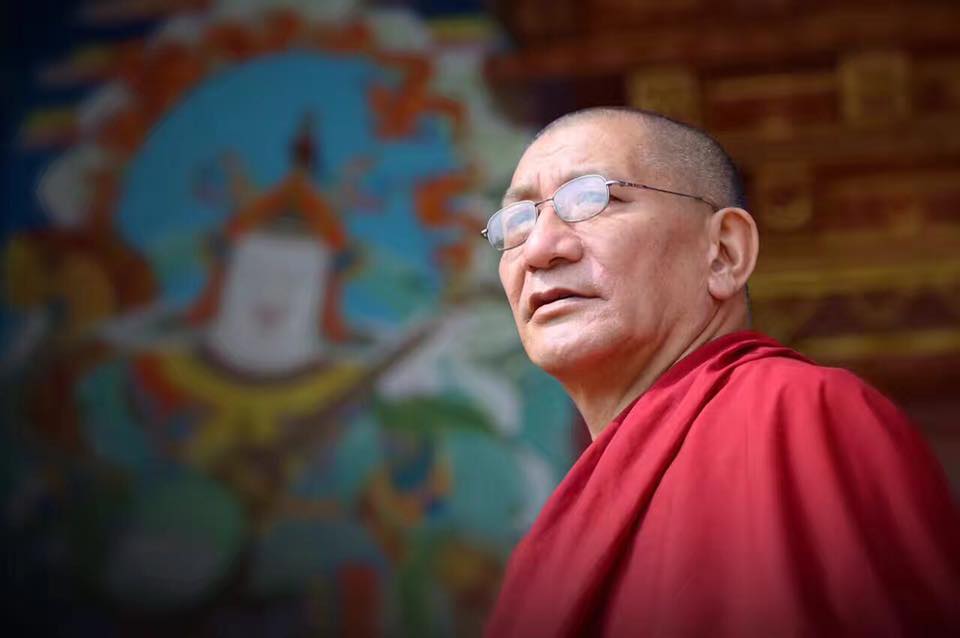Gyurme Tenpa Gyaltsen, the fourth Kathok Getse Rinpoche and the seventh head of the Nyingma tradition of Tibetan Buddhism, died on November 19 of injuries suffered in a fall near Pharping, Nepal. He was 64. He was the “Golden Throne” holder of the Kathok Monastery lineage, the oldest branch of the Nyingma tradition, which is the earliest of the four main schools of Tibetan Buddhism. Kathok Getse Rinpoche was gravely injured while leaving Kathok Ritrod, his monastery south of Kathmandu.
Just ten months before his death, in January 2018, Kathok Getse Rinpoche was named to a three-year term as the supreme head of the Nyingma. At the same time, five lamas, representing the other main Nyingma monastic lineages—Dzogchen, Shechen, Mindrolling, Dorje Drak, and Palyul—were appointed to serve three-year terms sequentially when Kathok Getse Rinpoche’s term ended. One of the five will now assume the post.
The Nyingma is the only Tibetan Buddhist school that historically had no supreme leader. The position was established by His Holiness the 14th Dalai Lama in the 1960s. It is largely administrative, although the holder is accorded great respect as a spiritual leader. The first person to receive the title was Dudjom Rinpoche (1904–1987); on his death it passed to a series of distinguished lamas that included Dilgo Khyentse Rinpoche (1910–1991) and Penor Rinpoche (1932–2009). Kathok Getse Rinpoche was the seventh to hold the title.
The original seat of the Kathok lineage, Kathok Dorje Den monastery, was established in Kham, Tibet, in 1159. Gyurme Tenpa Gyaltsen, born in 1954 in Golog, in eastern Tibet, was recognized by senior lamas as the reincarnation of the third Kathok Getse, Gyurme Tenpa Namgyal, who died in 1952. From an early age, he received teachings and empowerments from many distinguished masters. After leaving Tibet in 1999, he continued his studies in exile—the Dalai Lama and Penor Rinpoche were among his teachers—and spent many years on retreat in Nepal. Kathok Getse Rinpoche was renowned for his mastery of Dzogchen [Great Perfection] teachings, which are aimed at self-awakening and realization of the natural state of being and are central to the Nyingma tradition.
The Dalai Lama once said of his former student: “Kathok Getse Rinpoche, like his previous incarnations, illuminates the teachings of Nyingma, the first Buddhist doctrine of Tibet, and embodies a great living legacy of the Buddhist teachings.”
Soon after Kathok Getse Rinpoche’s death, reports began circulating of unusual circumstances attached to it, with some referring to it as his parinirvana, a Buddhist term reserved for a kind of “super-nirvana,” the after-death experience of spiritually accomplished people who attained nirvana, or enlightenment, in life. According to these reports, based largely on first-person accounts, Kathok Getse Rinpoche’s demise was a “last lesson in impermanence” for those around him. And he had been eerily prescient about it.
On the evening of November 18, as he prepared to leave Kathok Ritrod for Adzom Monastery nearby, Kathok Getse Rinpoche reportedly chatted “half jokingly” about impermanence with his two attendant lamas. “If I were to die tomorrow,” he told them, they should not disturb him at the moment of death and should carry out the specific funeral preparations he outlined.
The following day, Kathok Getse Rinpoche refused to travel by car to Adzom Monastery or even to walk on the road. Instead, accompanied by one attendant, he set out on foot, down a trail described as “quite treacherous.” When his attendant warned him not to go that way, Kathok Getse Rinpoche chided him: “You still have a very strong attachment to this physical body.” The attendant insisted on going first. Moments later, he turned around to see Kathok Getse Rinpoche rolling down the hill, apparently having lost his footing. He died soon after, and his body was taken to Adzom Monastery for traditional puja ceremonies.
At the time of his death, Kathok Getse Rinpoche was serving as abbot of Kathok Ritrod monastery and overseeing Chagdud Gompa as well as centers in India and Bhutan.
Thank you for subscribing to Tricycle! As a nonprofit, we depend on readers like you to keep Buddhist teachings and practices widely available.
